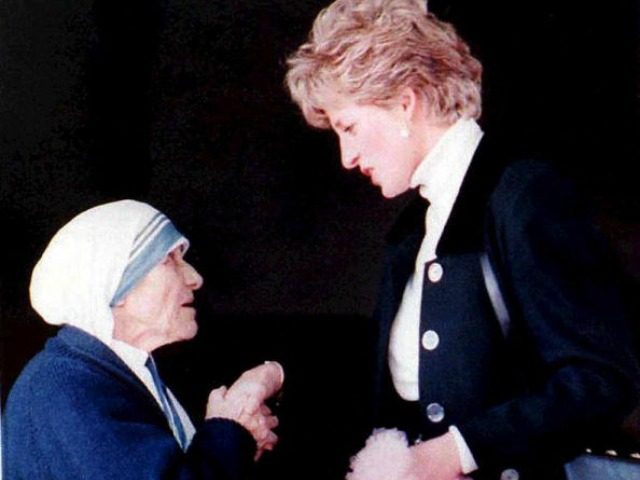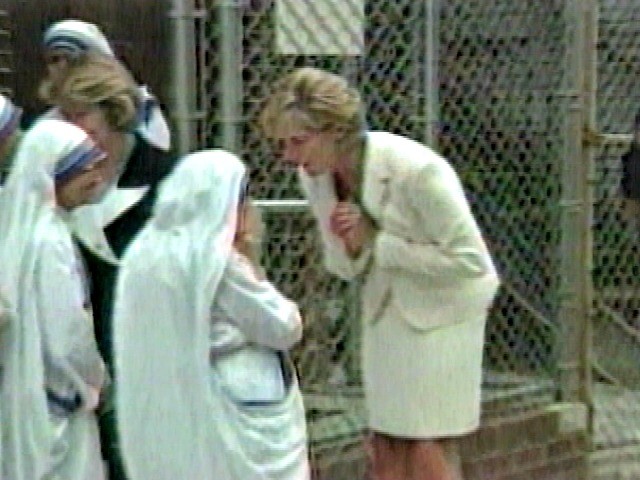In September of 1997, the world lost two of its most famous women – Diana, the former Princess of Wales, and Mother Teresa of Calcutta.
The vast differences between the lives of the two women are obvious. Yet, they died within several days of each other and the fact that Diana was buried following her tragic death with a rosary in her folded hands given to her by Mother Teresa, has led some in the media to reflect on both the contrast and the connection between the two.
On September 7, 1997, NBC Today Show featured “Princess Diana and Mother Teresa,” with Jack Ford as co-host and Scott Simon of NPR/PBS reporting:
Ford:
Britain and the world said final farewells to Diana in this week in London. And on Friday, the announcement came from Calcutta of another historic loss: the death of Mother Teresa. Scott Simon, of National Public Radio and PBS once worked with Mother Teresa in Calcutta; he joins us this morning.
Scott, the–the loss of such symbols in one week.
Simon:
It–it–it is utterly an amazing coincidence that the two most famous women in the world really, according to surveys, should die within just a few days of each other. And while they were very different, to be certain, they were friends. Princess Diana, in fact, was buried holding a rosary given to her by Mother Teresa. And this weekend their losses seem to resonate with some similar meanings.
The Princess of Wales had a fairy tale life that went sour, and then was cut short. Mother Teresa had a life out of biblical scripture that grew rich in years and reverence. Mother became one of the most revered persons of the modern world by shunning much of what the modern world reveres–money, things, even the good things good people often want: comfort and security. Mother Teresa believed human beings didn’t suffer from poverty, but became richer by it. She told those who sought her out to ask, “What can I do to help?” – “Give until it hurts.”
Princess Diana was born into privilege, married into and even died in opulence. She spent most of her life in comfortable pursuit of `good things’. The hurt of her unhappy marriage and the pain of her public humiliations only reminded much of the watching world that not even the wealth of the Windsors can buy love.
Mother Teresa had no less of a shrewd trademark–her homespun, blue-striped, white cotton sari. Reported value: about a dollar. She wore it before the beribboned audience in Stockholm who awarded her the Nobel Peace Prize and refused to change from it before her first meeting with the pope, saying, `These clothes are good enough for God.’ The pope knelt to kiss her hand and said he felt humbled.
NBC reported that, in reacting to Diana’s death, Mother Teresa said just prior to her own passing, “You could see that she was very much concerned about the poor people and she wanted to give something, by helping me to help them, and that’s a beautiful thing.”
Simon:
While you cannot compare Mother Teresa’s life of service with Princess Diana’s occasional missions of charity, looking through the pictures of their lives this week, you’re struck by the way each of them reached out, in a way both loving and lovely, to touch hurt with their hands–caressing and comforting those suffering from biblical diseases, like leprosy and age-old poverty, and modern afflictions, including AIDS, land mines, and homelessness.
And almost certainly, there will be calls for Mother Teresa to be canonized a saint. Mother herself always rejected such talk. Yet for millions of people living in a century that did much to make us cynical, Mother Teresa was a glimpse of God even agnostics could respect. In our time, she was `the Word of God made flesh.’
The Missionaries of Charity say that Mother Teresa leaves this world owning only two pairs of sandals and two pairs of eyeglasses, a wooden wash bucket, a worn sweater, a well-thumbed Bible, and an olivewood rosary. She was almost as poor as she strived to be.
As Mother Teresa is canonized a saint on Sunday, Stephanie Mann recalls the media frenzy over the death of Diana, and describes her funeral as “her canonization.” She writes at National Catholic Register:
Debate raged about who was to blame for her death after a car crash in Paris: the drunken limousine driver, the paparazzi, or the Royal Family…
Diana’s funeral, held in Westminster Abbey, included both tradition and innovation, with Sir Elton John singing a special version of “Candle in the Wind”, originally written about Marilyn Monroe, and her brother’s eulogy which attacked the press and criticized the Royal Family. English pomp and circumstance combined with celebrity status. Hundreds of thousands watched the services on screens in Hyde Park and the funeral was carried live on TV and radio. The media tones were hushed and reverential for “the people’s princess.”
Mann contrasts the coverage of Diana’s death and funeral with that of Mother Teresa:
Mother Teresa of Calcutta had died the day before Diana’s funeral, on September 5, 1997. While she was granted the honor of a State funeral in India, ABC News with Peter Jennings chose to have Christopher Hitchens, her most virulent critic, add his commentary to the broadcast of her funeral Mass.
She aptly describes Mother Teresa’s funeral on September 13 in an indoor stadium as “reverent and orderly…with none of the magnificence of Westminster Abbey.”
Mother Teresa’s words upon Diana’s death and the princess’ burial with the future saint’s rosary in her hands inspires Mann to call for prayer “for the intercession of the Saint” and “for the soul of the Princess.”


COMMENTS
Please let us know if you're having issues with commenting.